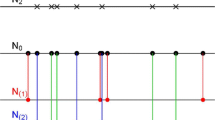Abstract
The main contribution of this work is a bootstrap test to check the independence between temporal nonhomogeneous Poisson processes. The test statistic is based on the close point relation, which adapts the crossed nearest neighbour distance ideas of spatial point processes to the case of nonhomogeneous time point processes. Since it is complicated to obtain the probability distribution of the test statistic under the null hypothesis and the parameters of the processes are usually unknown, the \(p\) value is obtained using a parametric bootstrap approach. A simulation study shows that the size of the test is close to the nominal one. The power is analyzed considering three approaches for generating dependent nonhomogeneous processes and different levels of dependence, and satisfactory results are obtained in all cases. Although the test was initially intended for Poisson processes, it can be applied to any type of point process in one dimension which can be simulated. This test is a valuable tool in the validation analysis of common Poisson shock models. For the bivariate case, the process can be decomposed into three independent Poisson processes, and the assumption of independence between them has to be checked. As an application, the joint modeling of the occurrence process of extreme heat events in daily maximum and minimum temperatures is described.





Similar content being viewed by others
References
Abaurrea J, Asín J, Cebrián AC, Centelles A (2007) Modeling and forecasting extreme heat events in the central ebro valley, a continental-mediterranean area. Glob Planet Change 57(1–2):43–58
Allard D, Brix A, Chadoeuf J (2001) Testing local independence between two point processes. Biometrics 57:508–17
Andrews DWK (1997) A conditional kolmogorov test. Econometrica 65(5):1097–1128
Baddeley AJ, Møller J, Waagepetersen R (2000) Non and semi-parametric estimation of interaction in inhomogeneous point patterns. Statistica Neerlandica 54:329–350
Baddeley A, Turner R, Møller J, Hazelton J (2005) Residual analysis for spatial point processes. J R Stat Soc B 67(5):617–666
Coles S (2001) An introduction to statistical modeling of extreme values. Springer, Berlin
Coles S, Heffernan J, Tawn J (1999) Dependence measures for extreme value analysis. Extremes 2(4):339–65
Comas C, Mateu J, Särkkä A (2010) A third-order point process characteristic for multi-type point processes. Statistica Neerlandica 64:19–44
Cuzick J, Edwards R (1990) Spatial clustering for inhomogeneous populations. J R Stat Soc B 52:73–104
Daley D, Vere-Jones D (2003) An introduction to the theory of point processes. Vol I: elementary theory and methods. Springer, Berlin
Davidson R, MacKinnon JG (2006a) Bootstraps methods in econometrics. In: Patterson K, Mills TC (eds) Palgrave handbook of econometrics: volume 1 theoreticaleconometrics. Palgrave Macmillan, Basingstoke, pp 812–838
Davidson R, MacKinnon JG (2006b) The power of bootstrap and asymptotic tests. J Econom 133:421–441
Díaz-Avalos C, Juan P, Mateu J (2014) Significance tests for covariate-dependent trends in inhomogeneous spatio-temporal point processes. Stoch Environ Res Risk Assess 28:593–609
Diggle PJ (1979) On parameter estimation and goodness-of-fit testing for spatial point patterns. Biometrics 35(1):87–101
Diggle PJ (2003) Statistical analysis of spatial point patterns, 2nd edn. Oxford University Press, Oxford
Doss H (1989) On estimating the dependence between two point processes. Ann Stat 17(2):749–763
Dufour JM (2006) Monte Carlo test with nuisance parameters: a general approach to finite-sample inference and nonstandard asymptotics. J Econom 133:443–477
Dutilleul P (2011) Spatio-temporal heterogeneity: concepts and analyses. Cambridge University Press, Cambridge
Eckel S, Fleischer F, Grabarnik P, Schmidt V (2008) An investigation of the spatial correlations for relative purchasing power in Baden–Württemberg. Adv Stat Anal 92:135–152
Engle RF, Hendry DF, Richard JF (1983) Exogeneity. Econometrica 51(2):277–304
Ericsson NR, Irons JS (1994) Testing exogeneity. Oxford University Press, Oxford
Guan Y, Afshartous D (2007) Test for independence between marks and points of marked point processes: a subsampling approach. Environ Ecol Stat 14:101–111
Hennig C, Hausdorf B (2004) Distance-based parametric bootstrap tests for clustering of species ranges. Comput Stat Data Anal 45(4):875–895
Horowitz JL (2001) The bootstrap. In: Heckman JJ, Leamer EE (eds) Handbook of econometrics, 1st ed, vol 5. Elsevier, Amsterdam, pp 3159–3228
Isham V (1980) Dependent thinning of point processes. J Appl Probab 17(4):987–995
Keilson J, Servi LD (1994) Networks of nonhomogeneous \(m/ g/ \infty \). J Appl Probab 31:157–168
Lindskog F, McNeil AJ (2003) Common poisson shock models: applications to insurance and risk modelling. ASTIN Bull 33:209–238
Marcon E, Puech F (2009) Generalizing Ripley’s K function to inhomogeneous populations. Working papers Halshs, 00372631-v1, HAL
Palecki MA, Changnon SA, Kunkel KE (2001) The nature and impacts of the July 1999 heat wave in the midwestern United States: learning from the lessons of 1995. B Am Meteorol Soc 82:1353–1367
Schlather M, Ribeiro PJ, Diggle PJ (2004) Detecting dependence between marks and locations of marked point processes. J R Stat Soc B 66(1):79–93
van Lieshout MNM, Baddeley AJ (1999) Indices of dependence between types in multivariate point patterns. Scand J Stat 26(4):511–532
Acknowledgments
This work was partially supported by Ministerio de Educación y Ciencia (Spanish Department of Science) and Ministerio de Medio Ambiente (Spanish Department of Environment) through the projects CGL2009-09646 and ESTCENA 2009/0017. We also thank the anonymous reviewers and the editors for their helpful comments.
Author information
Authors and Affiliations
Corresponding author
Additional information
Handling Editor: Pierre Dutilleul.
Rights and permissions
About this article
Cite this article
Abaurrea, J., Asín, J. & Cebrián, A.C. A bootstrap test of independence between three temporal nonhomogeneous Poisson processes and its application to heat wave modeling. Environ Ecol Stat 22, 127–144 (2015). https://doi.org/10.1007/s10651-014-0288-1
Received:
Revised:
Published:
Issue Date:
DOI: https://doi.org/10.1007/s10651-014-0288-1




